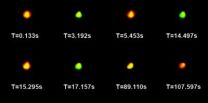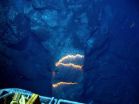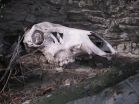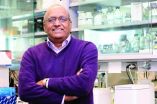(Press-News.org) Calculations by researchers at the University of California, San Francisco and the University of California, Berkeley estimate that the cancer risk associated with one type of airport security scanners is low based on the amount of radiation these devices emit, as long as they are operated and function correctly.
"The doses are low – extremely low," said Rebecca Smith-Bindman, MD, a professor of radiology at UCSF, who made the calculations with Pratik Mehta, an undergraduate at UC-Berkeley. "The amount of radiation in these scans is so low that you don't have to be concerned about it."
The amount of radiation absorbed in a single scan, they say, is about the same as what the average person absorbs every three to nine minutes on the ground – just from being alive. (The human body naturally absorbs radiation all the time from such sources as the sun and the earth). In their analysis, Smith-Bindman and Mehta also determined that the average person would absorb 100 times more radiation flying on an airplane than standing in a scanner.
At the same time, Smith-Bindman cautions that the analysis is based on the assumption that the backscatter devices work perfectly and are used as designed.
How certain can Americans be that there are not as-yet-unknown safety risks? For instance, is there potential for software glitches, human errors or mechanical malfunctions that could cause the scanners to exceed their design specifications and expose people to higher levels of radiation?
Questions like these are valid, said Smith-Bindman. She concludes that it would be prudent for the U.S. Transportation Security Administration (TSA) to allow further testing and monitoring of the devices in the field. Currently the TSA does not permit scientists to have access to the scanners to do independent testing.
"Given how many people are being exposed to these machines," she said, "I would just want to make sure no possible unanticipated error could happen."
The analysis appears in a special article published online on Monday, March 28, 2011 in the journal Archives of Internal Medicine.
Scanners to Double in Number this Year
Ever since a failed bombing attempt in December of 2009, when a passenger on a Detroit-bound flight successfully boarded a plane with explosives hidden in his underwear, "backscatter" radiation scanners have been deployed more and more in airports across the country.
About 500 of these scanners have appeared in 78 U.S. airports so far, and the federal government ultimately has plans to double the number of them by the end of this year, said Smith-Bindman. Backscatter scanners are different from millimeter wave scanners, also used in airport security, which image the body using a different type of energy than ionizing radiation.
Because backscatter scanners use low energy X-rays to penetrate clothing, image the human body and reveal hidden articles underneath, they have drawn public scrutiny about privacy concerns and potential health risks.
X-ray radiation can damage DNA, causing a cancer risk with exposure to X-rays from any source. Taking the available published specifications for the backscatter instruments, however, Smith-Bindman and Mehta determined that the amount of radiation absorbed from routine scanning is relatively low and the added risk of developing cancers is likewise low.
About 100 million passengers take 750 million flights in the United States each year, and Smith-Bindman and Mehta calculated that fully implementing backscatter scanners would not significantly increase the lifetime risk of cancer for travelers.
They also looked at the U.S. population that may be at greatest risk: children. Because children are expected to live longer than adults, their lifetime risk of cancer would be higher.
Smith-Bindman and Mehta focused on a subset of children, considering five-year-old girls who fly round trip once a week. Even within this frequent flying group, they estimated that backscatter scanners would not significantly increase their lifetime risk of cancer.
INFORMATION:
UCSF is a leading university dedicated to promoting health worldwide through advanced biomedical research, graduate-level education in the life sciences and health professions, and excellence in patient care.
Follow UCSF on Twitter at @ucsf/@ucsfscience
Analysis suggests cancer risk of backscatter airport scanners is low
2011-03-29
ELSE PRESS RELEASES FROM THIS DATE:
Twinkle, twinkle, quantum dot -- new particles can change colors and tag molecules
2011-03-29
COLUMBUS, Ohio – Engineers at Ohio State University have invented a new kind of nano-particle that shines in different colors to tag molecules in biomedical tests.
These tiny plastic nano-particles are stuffed with even tinier bits of electronics called quantum dots. Like little traffic lights, the particles glow brightly in red, yellow, or green, so researchers can easily track molecules under a microscope.
This is the first time anyone has created fluorescent nano-particles that can change colors continuously.
Jessica Winter, assistant professor of chemical and ...
Bixby Land Company Acquires $58 Million in Industrial Properties
2011-03-29
Bixby Land Company, a leading commercial real estate operator and investment manager based in Orange County, Calif., has purchased four Class A industrial properties totaling approximately 850,000 square feet. The acquisitions increase Bixby Land Company's wholly-owned portfolio to more than 5 million square feet and point to Bixby's increasing investment activity as California property markets show signs of improvement.
"Our investment in these high-quality properties is a reflection of our confidence in the recovery of commercial real estate, in particular the industrial ...
The Birth of a Novel: Josie Brown's THE BABY PLANNER is Nurtured by the Profession it Touts
2011-03-29
Conception is a blessed event, be it a child's, or a new book. That is novelist Josie Brown's contention. She should know. The idea for her fourth novel, The Baby Planner [Simon & Schuster/Gallery Books]--about a childless woman who channels her nurturing instincts toward her pregnant clients--was born in the reception area of her mammogram center.
"I picked up the only reading material available: a local parenting magazine," explains Brown, who lives in the San Francisco Bay Area. "My own children are older, so it wasn't necessarily something I felt might interest ...
Deep-sea volcanoes don't just produce lava flows, they also explode!
2011-03-29
Between 75 and 80 per cent of all volcanic activity on Earth takes place at deep-sea, mid-ocean ridges. Most of these volcanoes produce effusive lava flows rather than explosive eruptions, both because the levels of magmatic gas (which fuel the explosions and are made up of a variety of components, including, most importantly CO2) tend to be low, and because the volcanoes are under a lot of pressure from the surrounding water.
Over about the last 10 years however, geologists have nevertheless speculated, based on the presence of volcanic ash in certain sites, that explosive ...
OAI: News of Fee Increase Highlights Peculiarities of Mich. Auto Insurance Market
2011-03-29
Last week, the Michigan Catastrophic Claims Associations (MCCA) announced it would be instituting a slight fee increase that will be passed on to policyholders in the state.
Car insurance providers currently are required to pay the MCCA $143.09 per insured vehicle, which gets incorporated into the premiums of even the cheapest auto insurance companies in the state. That amount will be raised 1.3 percent starting in July. The fee revenue goes into an MCCA-administered fund that exists as a result of the unorthodox structure of Michigan's no-fault system.
Unlike the ...
Bones conjure Yellowstone's ecological ghosts
2011-03-29
By taking a closer look at animal bones scattered across the wilderness landscape, a researcher at the University of Chicago has found a powerful tool for showing how species' populations have changed over decades or even a century.
"The skeletons of long-dead animals lying on landscapes provide critical insight into our understanding of ecosystem history, especially how populations have changed," said the study's author, University of Chicago alumnus Joshua H. Miller, S.M.'05, PhD'09, a postdoctoral research fellow in biological sciences at Wright State University in ...
AmeriSus Partners with HomeSphere
2011-03-29
Lakewood-based HomeSphere, Inc. announced today that they have entered into a partnership with the American Sustainability Initiative (AmeriSus) to effectively manage manufacturer rebates with their BRI and AllTrack applications.
Inspired by the Sears kit houses of the 1930s, AmeriSus manages all design, engineering, product and technology selections, procurement, logistics and scheduling for home builders, in order to deliver all materials necessary to construct an affordable, super-efficient homes for the end consumer. AmeriSus catalog homes are designed to fit into ...
Human virus linked to deaths of endangered mountain gorillas
2011-03-29
For the first time, a virus that causes respiratory disease in humans
has been linked to the deaths of wild mountain gorillas, reports a
team of researchers in the United States and Africa.
The finding confirms that serious diseases can pass from people to
these endangered animals.
The researchers are from the non-profit Mountain Gorilla Veterinary
Project; the Wildlife Health Center at the University of California,
Davis; the Center for Infection and Immunity at Columbia University;
and the Rwanda Development Board.
Their study, which reports the 2009 deaths ...
International Diabetes Federation supports surgery to treat diabetes
2011-03-29
NEW YORK (March 28, 2011) -- Bariatric surgery should be considered earlier in the treatment of eligible patients to help stem the serious complications that can result from diabetes, according to an International Diabetes Federation (IDF) position statement presented by leading experts at the 2nd World Congress on Interventional Therapies for Type 2 Diabetes in New York.
The statement was written by 20 leading experts in diabetes and bariatric surgery who have made a series of recommendations on the use of weight-loss surgery as a cost-effective treatment option for ...
Research proves no 2 of us are alike, even identical twins
2011-03-29
Just like snowflakes, no two people are alike, even if they're identical twins according to new genetic research from The University of Western Ontario. Molecular geneticist Shiva Singh has been working with psychiatrist Dr. Richard O'Reilly to determine the genetic sequencing of schizophrenia using identical or monozygotic twins. The study is published in this month's PLoS ONE.
Singh looked at about one million markers of identical twins (and their two parents) where only one twin had schizophrenia. "The most informative feature of schizophrenia is that it sometimes ...





